According to the State of Michigan, the total number of COVID cases in Michigan rose to 54,881 on May 25, an increase of 202 cases from the previous day. This total was equivalent to 550 cases per 100,000 people (Chart 4). Of those 202 cases 80 were documented in Southeastern Michigan. This means that of the new daily COVID cases Southeastern Michigan accounted for 40 percent of them, highlighting how most of the new cases continue to occur outside of the region. Additionally, in recent days, the number of new daily cases statewide has been decreasing. The amount reported on May 25 was the lowest reported since March 22 (a lower number was reported on May 4 but the State had technically difficulties in reporting the data that day). The five-day rolling average for the total number of COVID cases (Chart 1) reflects a smoother curve and adjusts for fluctuations in testing and/or the quality of reporting or failure to report.
Chart 2 shows that, based on the five-day rolling averages, the growth of new COVID cases in Southeastern Michigan continued to level off for the counties in the region. The flattening of the COVID growth curves in Southeastern Michigan also further supports how the increase of COVID cases is slowing in the region, with cases outside the region continuing to make up majority of the new daily COVID cases. On May 23 the number of cases in Detroit reached 10,643, the highest in the region, and Wayne County reported the second highest number of cases at 9,041. On May 23, the five-day rolling average for the number of COVID cases in Oakland County was 8,178, and Macomb County reported 6,472.
The City of Detroit had 1,595 COVID cases per 100,000 people on May 25, an increase from 1,591 the day before (Chart 3). This is based upon a reported increase of 28 new COVID cases, bringing the total number of COVID cases in Detroit to 10,727. Wayne County reported 844 cases per 100,000 people, and Oakland County had 654 cases per 100,000 people. These per capita rates were based upon 9,089 total cases for Wayne and 8,226 for Oakland. Macomb County reported 746 cases per 100,000 people, which is based upon 6,516 cases. All of these were minimal increases from the day prior.
The daily data highlighted in these posts is from Michigan.gov/coronavirus, where data is updated daily at 3 p.m. Historical data were supplied from covidtracking.com, which republishes COVID data from the State. Additionally, the case totals do not reflect the number of people who have recovered, just those who have been infected.
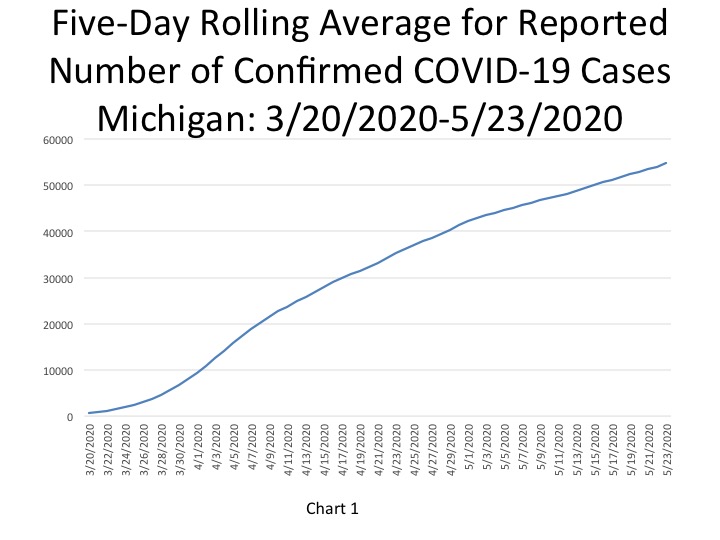
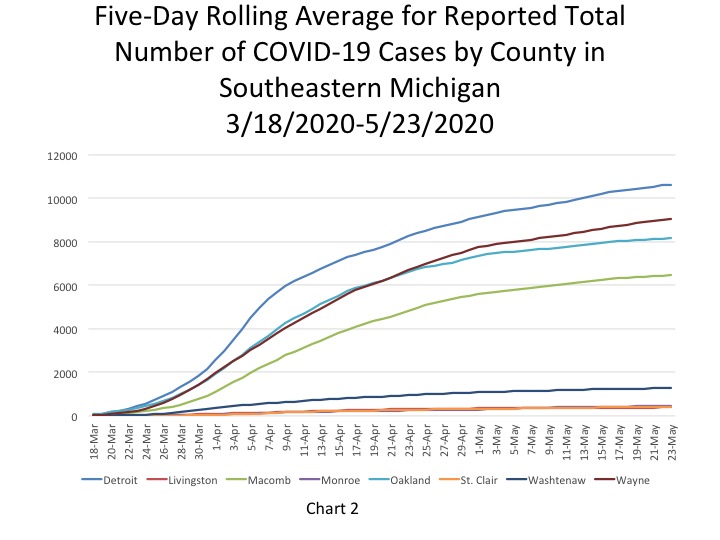
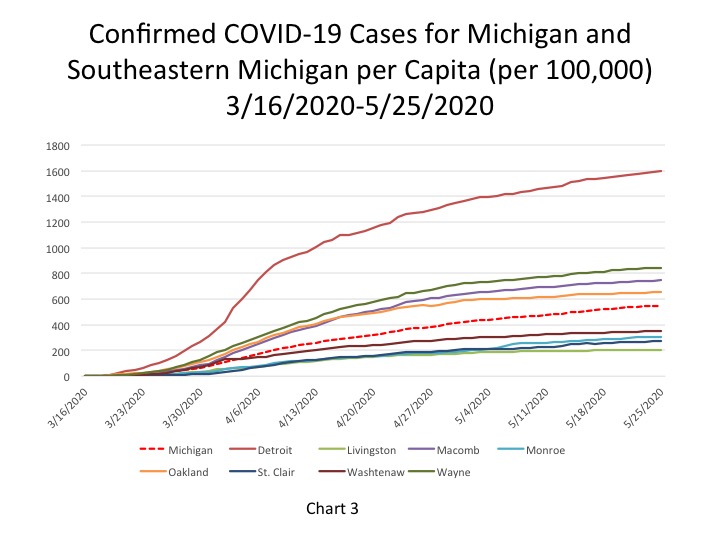
Chart 4 shows that Detroit reported the highest number of daily cases at 46 on May 23, a decrease of 10 from the day prior. Such decreases of new daily cases was mirrored throughout the region, showing how the overall of increase of new COVID cases in Southeastern Michigan is flattening and/or declining.
On May 25 the per capita rate for the number of new daily COVID cases per 100,000 people was 2 for the State. The per capita rate was equivalent to 202 new cases, the lowest that has been reported in weeks. The City of Detroit was the only government entity in the region to report a higher per capita rate for the number of new daily COVID cases per 100,000 people than the State. On May 25 Detroit reported a per capita rate of 4 new COVID cases per 100,000 people, which was equivalent to 28 new cases. Wayne County reported 2 new COVID cases per 100,000, which was equivalent to 17 new cases. Oakland County reported a per capita rate of 1 new cases per 100,000 people on May 25, which was equivalent to 11 new cases, and Macomb County reported a rate of 2, which was also equivalent to 17 new cases. Overall, 80 new COVID cases were reported in Southeastern Michigan on May 25. This is a decrease in the total number of daily COVID cases in Southeastern Michigan from the day prior.
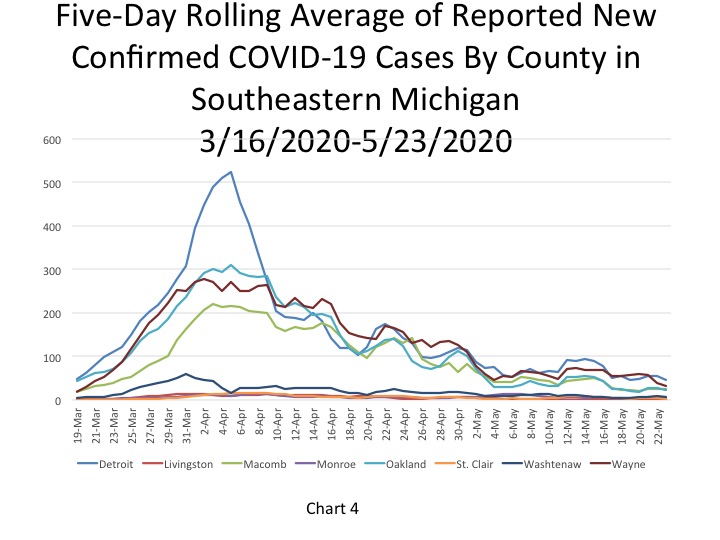
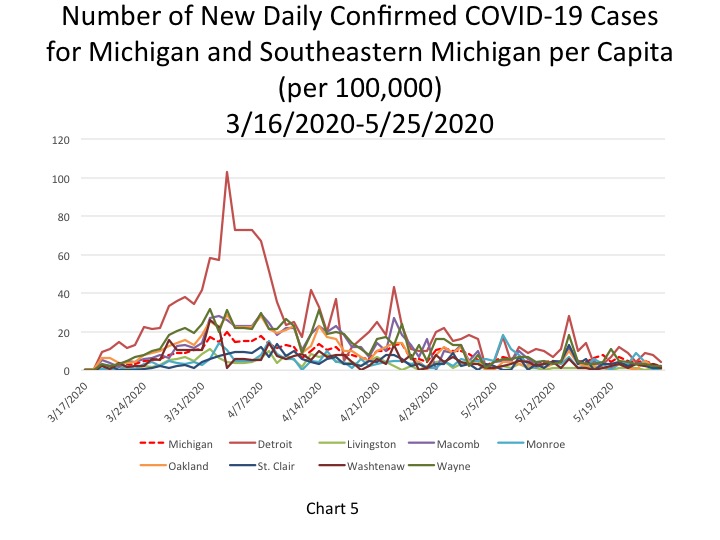
In Chart 6, the five-day rolling average for the number of deaths in Michigan shows a continuing slow increase (a lagged number of 5,196 deaths, an increase of 36 deaths). The actual reported COVID-19 on May 25 was 5,240, an increase of 12 deaths from the day prior. Of those 12 additional deaths Southeastern Michigan accounted for 6 of them. The 12 deaths reported on May 25 is among the lowest daily count in the last two months.
Chart 7 (a 5-day rolling average) portrays how the total number of COVID deaths in Southeastern Michigan continues to increase at a much slower rate in recent days, with Detroit reporting the highest cumulative number of deaths at 1,313 on May 22. Wayne County had the second highest total at 1,032 on May 22.
Chart 8 portrays the total number of COVID deaths per 100,000 people on May 25, and all the per capita rates in Southeastern Michigan and for the State remained the same as the previous day. The State of Michigan had 52 COVID deaths per 100,000 people, which was equal to 5,240 total deaths. The State has reported a per capita rate of 52 deaths for four days in a row now. The cumulative total of COVID deaths per 100,000 people in Detroit was 197 (representing 1,322 deaths). In Wayne County there were 97 COVID deaths per 100,000 people (1,042 total deaths). In Oakland County there were 76 deaths per 100,000 people (955 total deaths-an increase of 0 from the day prior) and in Macomb County there were 89 COVID deaths per 100,000 people (778 total-an increase of 0 from the day prior). Wayne County had the highest single day death count in Southeastern Michigan on May 25; 3 COVID deaths were reported. Detroit and St. Clair County were the only other entities in the region to report new deaths and those were reported at 2 and 1, respectively.
Chart 9, the five day rolling average of deaths, shows the number of new statewide deaths decreased by 6 from the day prior. On May 23 the State reported 36 COVID deaths. Chart 10 shows how the number of deaths in Southeastern Michigan have been either leveling off or decreasing. Detroit reported 8 daily COVID deaths, which was a decrease of 2 from the day prior, further confirming that the number of deaths, at least in areas of Southeastern Michigan, are continuing to decline. On May 23, of the 36 new deaths reported 24 were reported out of Southeastern Michigan. These numbers are based on 5-day rolling averages.
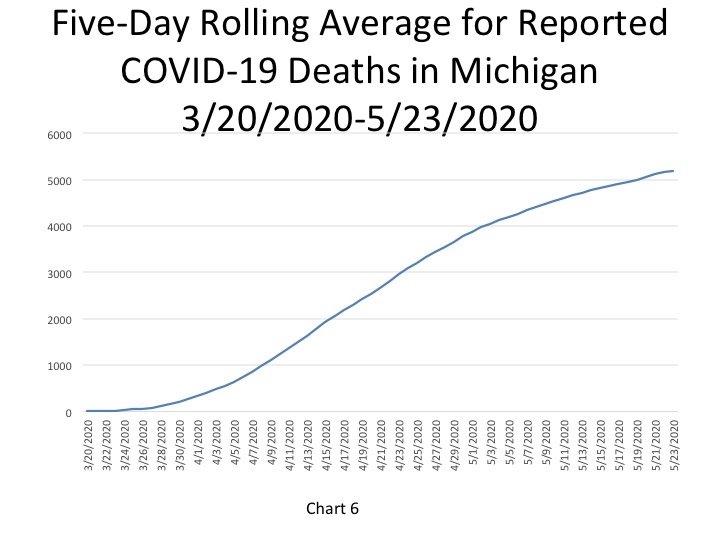
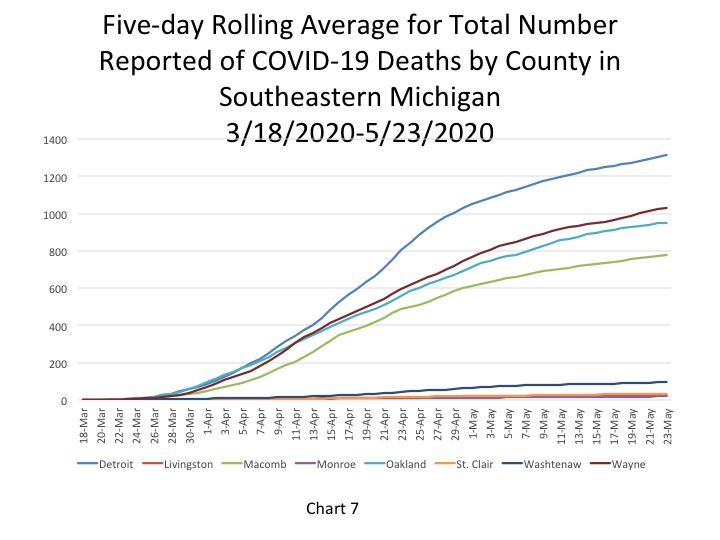
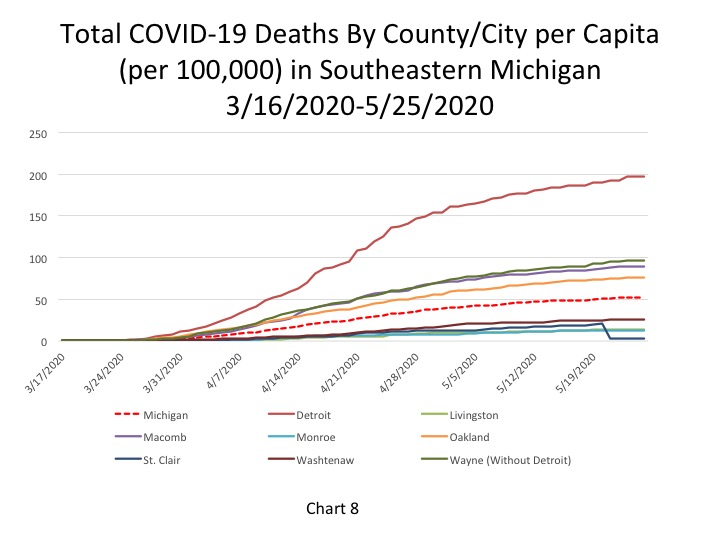
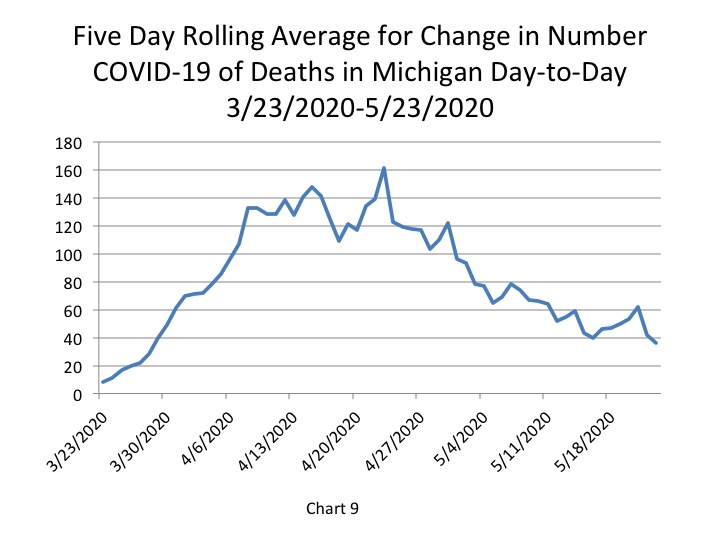
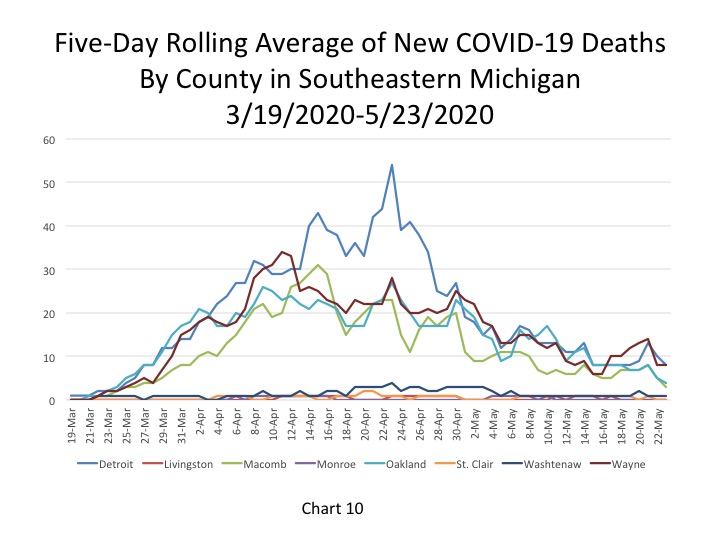
On May 25 Detroit reported a fatality rate of 12.4 percent, showing that while it is the highest rate in the region it has been maintaining at just above 12 percent since May 8. The fatality rate in Macomb County remained at 12 percent, and the State continued to report a fatality rate of 9.6 percent for a week straight.
One reason we may be seeing such high fatality rates in Michigan is due to the low testing rates. When only having-presumably-a lower of number confirmed COVID cases than is actually likely due to the limited availability of tests, the fatality rate appears higher because the base comparison is smaller than it might be.
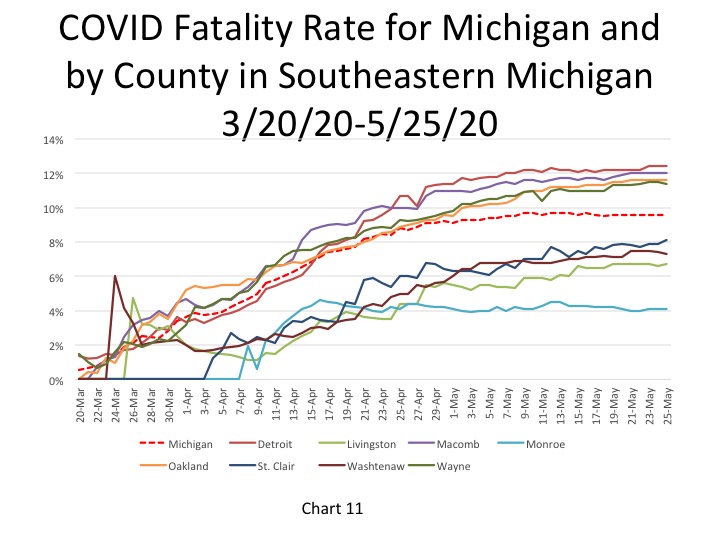
On May 24 the lowest number of deaths (5) was reported since March 22 and on May 25 the lowest number of new cases was recorded (both excluding when the State had technical difficulties in uploading data on May 4). Such a low reports bring hope that the spread of the virus and the havoc it has wreaked on families across this State, country and world may be, at the very least, becoming more manageable. But, as the State slowly begins to open up we will see if the spread has truly slowed, which is dependent on people respecting orders such as wearing masks and social distancing.